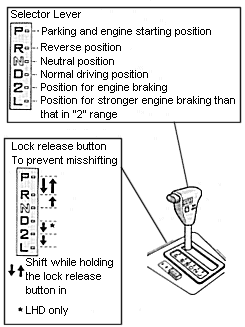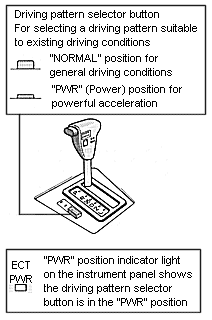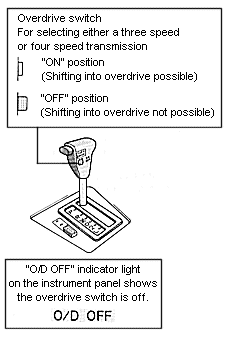Automatic Transmission
 |  |  |
(a) Normal driving
- Start the engine as instructed in "How to start the engine" in Part 3.
The transmission must be in "P" or "N". The engine will not start in "R", "2", "L" or "D" range even if the key is turned. - Set the driving pattern selector button to the "NORM" position.
Your transmission is fitted with a driving pattern selector button which allows you to select either "NORM" or "PWR" to suit your driving condition. For ordinary driving, Toyota recommends that you use the "NORM" position to improve fuel economy. For powerful acceleration, use the "PWR" position. In the "PWR" position, the "PWR" position indicator light is on and the transmission is shifted up and down at a higher vehicle speed than in the "NORM" position. - Push the overdrive switch to set it on.
Always turn the overdrive switch on for better fuel economy and quieter driving (See (b) Using engine braking and (f) Good driving practice for exceptions.) - With your foot holding down the brake pedal, shift the selector lever to "D".
CAUTION: Never put your foot on the accelerator pedal while shifting.
- Release the parking brake and brake pedal.
Depress the accelerator pedal slowly for smooth starting.
The vehicle will start in the first gear and automatically shift to the second, third and overdrive gears according to the vehicle speed. However, while the engine coolant temperature is low and the vehicle is travelling at low speed, the transmission will not be shifted into the third gear and overdrive gear even with the overdrive switch on.
In "D" range, the automatic transmission system will select the most suitable gear for the running conditions such as hill climbing, hard towing, etc.
If you need to accelerate rapidly while driving, push the accelerator pedal all the way to the floor. The transmission will automatically downshift to the third, second or first gear, according to the vehicle speed.
If engine braking is needed, such as in descending a long hill, see (b) Using engine braking.
(b) Using engine braking
To use the braking power of the engine, downshift the transmission in the way described below:
- Turn off the overdrive switch. (This is effective only when you are driving in the "D" range.) The "O/D OFF" indicator light will come on and the transmission will downshift to the third gear.
- Shift into the "2" range. The transmission will downshift to the second gear when the vehicle speed is or becomes lower than the speed listed below and more powerful engine braking will be obtained.
- Shift into the "L" range. the transmission will downshift to the first gear when the cehicle speed is or becomes lower than the speed listed below and maximum engine braking will be applied.
| 7M-GE engine. | ||
| "2" | ................... | 117 km/h (73 mph) |
| "L" | ................... | 64 km/h (40 mph) |
| 7M-GTE engine. | ||
| "2" | ................... | 126 km/h (78 mph) |
| "L" | ................... | 69 km/h (43 mph) |
| CAUTION: Be careful when downshifting on a slippery surface. Abrupt shifting could cause the vehicle to spin or skid. |
(c) Using the "2" and "L" ranges
The "2" and "L" ranges are used for strong engine braking as described previously.
With the selector lever in "2" or "L", you can start the vehicle in motion as with the lever in "D".
With the selector lever in "2", the vehicle will start in the first gear and automatically shift to the second gear.
With the selector lever in "L", the transmission is engaged in the first gear.
NOTICE:
Be careful not to overrev the engine. Watch the tachometer to keep engine rpm from going into the red zone. The maximum allowable speed (approximate) for each range is given below for your reference:
7M-GE engine. "2" ................... 117 km/h (73 mph) "L" ................... 64 km/h (40 mph) 7M-GTE engine. "2" ................... 126 km/h (78 mph) "L" ................... 69 km/h (43 mph)
Do not continue hill climbing or hard towing for a long time in the "2" or "L" range. It may cause severe automatic transmission damage from overheating. To prevent such damage, "D" range should be used in the climbing or hard towing.
(d) Backing up
- Bring the vehicle to a complete stop.
- Pull the parking brake lever up fully to securely apply the parking brake
- With the brake pedal held down with your foot, shift the selector lever to the "R" range.
(e) Parking
- Bring the vehicle to a complete stop.
- Pull the parking brake lever up fully to securely apply the parking brake
- With the brake pedal held down with your foot, shift the selector lever to the "P" range.
| CAUTION:
While the vehicle is in motion, never attempt to move the selector lever into "P" under any circumstances. |
(f) Good driving practice
- If the transmission is repeatedly upshifted and downshifted between the third and overdrive gears when clibing a gentle slope, it is suggested that the overdrive switch be turned off. Be sure to turn the switch on immediately afterward.
- When towing a trailer, in order to maintain engine braking efficiency, do not use overdrive.
| CAUTION:
Always keep your foot on the brake pedal while stopping with the engine running. |
NOTICE:
Do not hold the vehicle on an upgrade with the accelerator pedal. It can cause the transmission to overheat. Always use the brake pedal or parking brake.
(g) If the "O/D OFF" indicator light flashes
Contact your Toyota dealer as soon as possible. There may be a trouble in the transmission system.